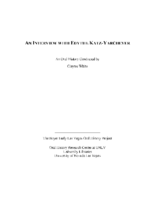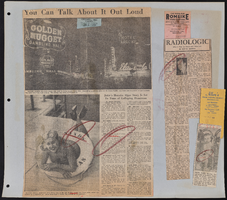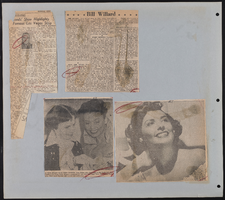Search the Special Collections and Archives Portal
Search Results
Elliott, Estrellita
"Interviewed by Vanessa Concepcion and Stefani Evans. Twins Estrellita "Estelle" and Julieta "Julia" Elliott were born in Manila and raised in Cebu City by their maternal grandparents. Their lawyer grandfather and Spanish professor grandmother raised them with a tricultural identity (Spanish, Filipino, and American) but with emphasis on their Castilian Spanish heritage. When they were twelve and their grandfather died, they went to live with their parents in Maryland, where their father was an educator and author and their mother was a concert pianist.
Person
Elliott, Julieta
"Interviewed by Vanessa Concepcion and Stefani Evans. Twins Estrellita "Estelle" and Julieta "Julia" Elliott were born in Manila and raised in Cebu City by their maternal grandparents. Their lawyer grandfather and Spanish professor grandmother raised them with a tricultural identity (Spanish, Filipino, and American) but with emphasis on their Castilian Spanish heritage. When they were twelve and their grandfather died, they went to live with their parents in Maryland, where their father was an educator and author and their mother was a concert pianist.
Person
JMA Architecture Studios
JMA (Jack Miller & Associates) was established by Jack Miller (1914-1999) in 1945 and is one of the oldest architectural firms in Las Vegas. Jack Miller came to Las Vegas in 1942 to assist in the design of the Basic Magnesium Plant in Henderson. As one of only a few architects working in Las Vegas after the war, Miller was able to establish a thriving practice designing all types of buildings: schools, residences, commercial and government buildings, hospitals and the original Stardust Hotel.
Corporate Body

Transcript of interview with Paul J. Christensen by Claytee D. White, February 19, 2008
Date
Archival Collection
Description
Text

Photograph of Harold Minsky and Jerry Norman, Las Vegas (Nev.), 1970-1979
Date
Archival Collection
Description
Image

Transcript of interviews with Edythe Katz-Yarchever by Claytee White, 2000-2005
Date
Archival Collection
Description
Transcript of interviews with Edythe Katz-Yarchever by Claytee White over the course of several sessions in 2000, 2003 and 2005. In the interviews, Katz-Yarchever discusses her life in Las Vegas, owning theaters with her husband, Lloyd Katz, and the strides they made in civil rights. She talks about her service in Civil Defense and the National Guard, and moving to various places, then working in California and meeting her husband, Lloyd. The Katzes became involved in the community in various ways with Operation Independence and Holocaust education. About a decade after Lloyd's death, Edythe married Judge Gilbert Yarchever.
Edythe Katz-Yarvhever was born in Boston, a second generation American whose grandparents left Russia the century before. Edythe completed finishing school at the start of World War II and worked various jobs at home before joining the Civil Defense, and later, the National Guard. She moved to Maryland and got a job as a secretary at Edgewood Arsenal, then transferred to Cushing General Hospital to assist a Marine Corps neurologist, who was also a Jewish refugee. Towards the end of the war, she is transferred to an Army hospital in Hawaii, and thus began the rest of her life on the West Coast. When the war ended, Edythe sailed to California and worked various jobs in Los Angeles: in the secretarial pool at MGM Studios, for a casting agency and for a hotel magazine. Edythe met Lloyd Katz in San Francisco, and the two were married after a short courtship. The couple lived in San Francisco before moving to Las Vegas in 1951, where they took over the management of the Huntridge, Palace and Fremont theaters, then leased by Edythe's parents. The Katzes took a stand to desegregate their theaters, allowing black customers to sit with white patrons. Edythe and Lloyd became active in the city's Civil Rights Movement, including work with Operation Independence and the NAACP. Edythe started organizations like Volunteers for Education and Junior Art League, and directed an interfaith, interracial preschool. Lloyd would frequently open up their theaters to organizations to hold fundraisers, free-of-charge. Edythe was extremely active in the local Jewish community, including opening the city's first Jewish gift shop, serving as sisterhood president at her synagogue and starting the Jewish Reporter. She later founded a library for Holocaust education as well as assisted the school district's development of curriculum and teacher training relating to the Holocaust. Lloyd Katz passed away in 1986, and in 1995, Edythe married Gilbert Yarchever. Edythe and Lloyd's community service work was honored with the naming of their school, the Edythe and Lloyd Katz Elementary School, where Edythe still remains active.
Text

Transcript of interview with Suzette Cox by Lance Cooper, March 1, 1979
Date
Archival Collection
Description
Text

Transcript of interview with George Burns by Sandy Fink, April 03, 1976
Date
Archival Collection
Description
Text


